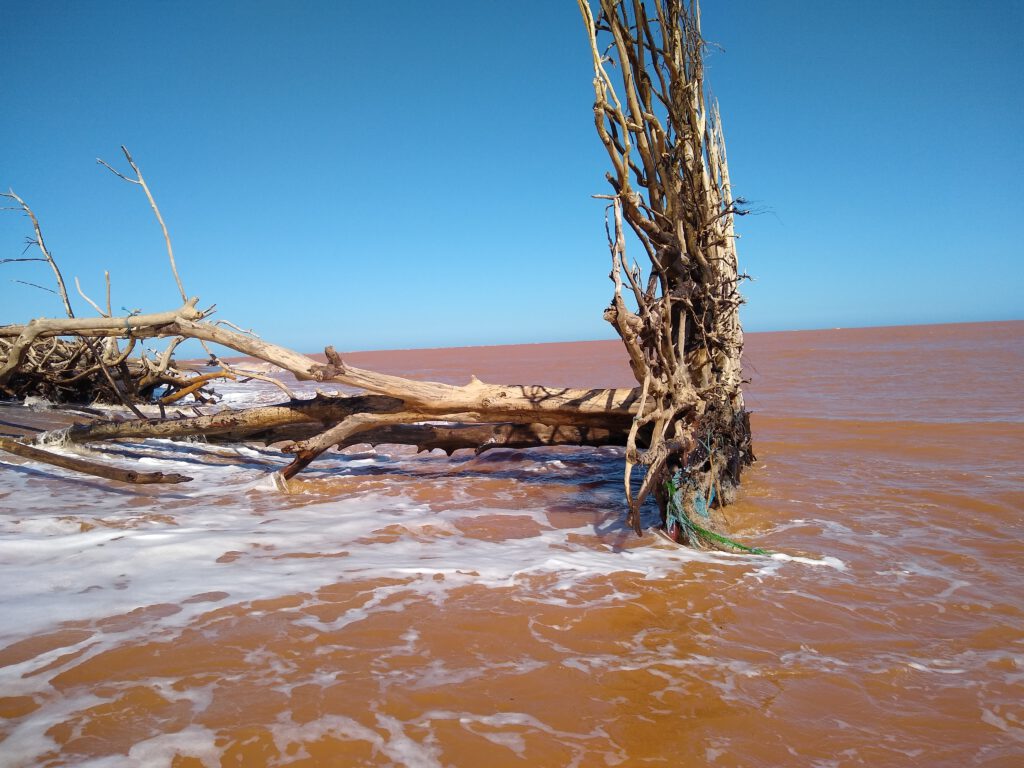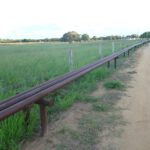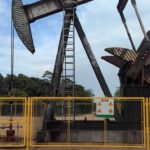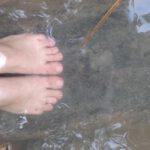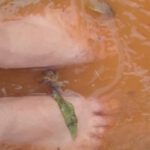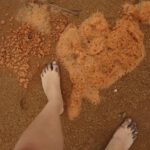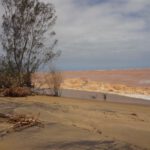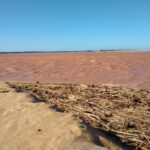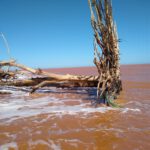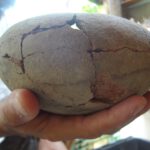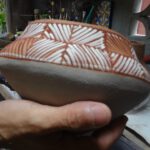Eliana S. J. Creado – Federal University of Espírito Santo, Brazil[1]
When we started to study the possibilities of sociotechnological disasters (see Zhouri et al., 2017) in a fishery village, called Regência Augusta, at Espírito Santo State, Brasil, where Doce River meets the Atlantic Ocean, we were thinking about something related to oil or gas pipelines. It was the first semester of 2015.[2]
At the beach, we can see five old oil storage tanks near a protected area devoted to the conservation of marine turtles nests, called Comboios. The presence of the oil pipelines becomes more grotesque and shocking if we go northwards and follow upstream of the Doce River, reaching two other small neighborhoods: Areal and Entre Rios.
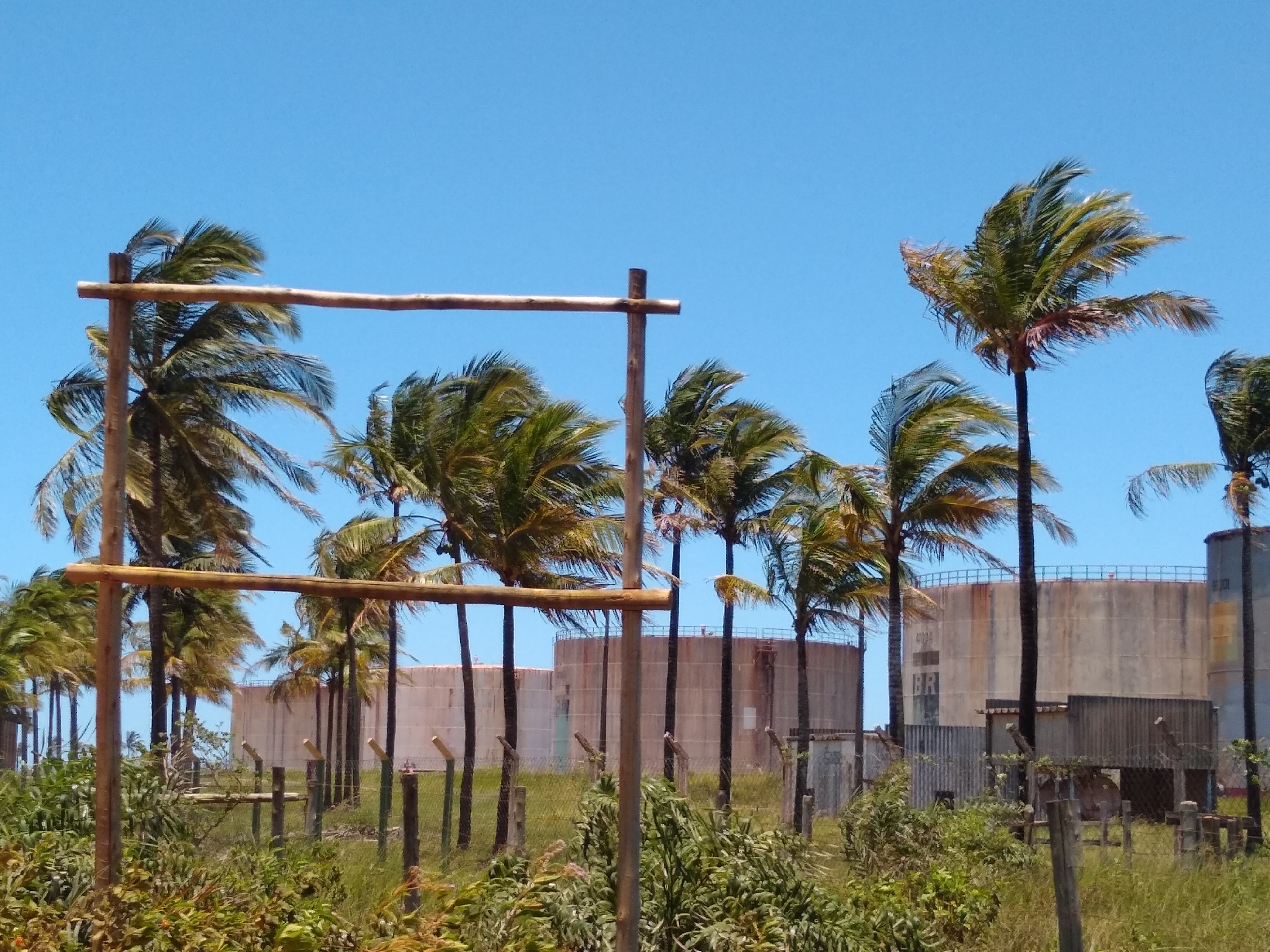
Image 1: Oil storage tanks, at an enclave in the protected area of Comboios and in the neighborhood village of Regência Augusta (February 2020)
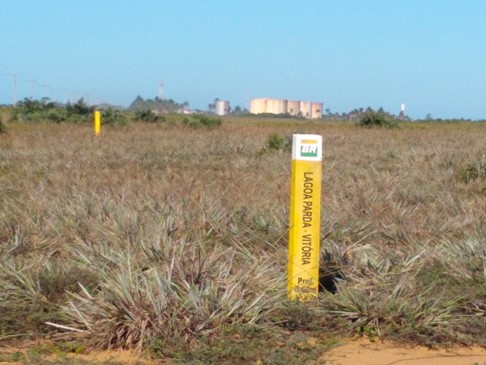
Image 2: Underground gas pipeline and oil barrels, amidst the coastal restinga vegetation on Comboios’ beach and protected area (February 2020)
At Areal and Entre Rios, the oil pipelines appear above the ground, along with oil pumpjacks. At Areal, the oil pipelines pass closely to the houses, and we could see children playing alongside them. During an interview, we also heard about an accident which happened in the 1980s, when during the installation of this infrastructure, there was a gas leak that caused a “a tongue of fire” for 18 days (see Trigueiro et al., 2018). Nowadays, the oil pumpjacks and pipelines are surrounded by warning signs which reveal the presence of risks to human life.
Image 3: Oil pipeline at Areal and pumpjack at Entre Rios
However, the sociotechnological disaster we followed in person was one related to iron mining, which was extracted and processed in a place more than 800 km away, in Bento Rodrigues, Mariana, Minas Gerais. On November 5th, 2015, a mine tailings dam managed by Samarco Mineração S.A. (a joint venture between the Brazilian Vale S.A. and the English-Australian BHP) collapsed, and, around two weeks after, tailings reached the mouth of the Doce river and the Atlantic Ocean. The trajectory of the ‘wave of mud’ (Creado and Helmreich, 2018) and its consequences have been extensively documented, as well as studied since then.[3]
Following Tsing et al (2017), the disaster can be called a “monster”. Mine tailings changed the aquatic landscape, and the people who lived in the mouth of Doce river (and not only them) named these sensorial changes as “Samarco’s mud”, “Samarco’s orange” or, as heard in a public meeting with fishers at Vitória, the capital of the state of Espírito Santo, “Samarco’s trash”.
When it rains in the upstream parts of the Doce River, “Samarco’s orange” returns and dominates the landscape again, so this is not just an isolated event, but rather a continuous disaster. In this context, the term crime has been used by some of the affected people when talking about the material and semantic fluxes caused by the disruption of the dam in public arenas.
Image 4: “Samarco’s orange”
On the left: Doce River’s clear water in November 2015, one week before the mine tailings meet the Atlantic Ocean; on the right, Doce River’s turbid water in December 2015, one week after the mine tailings arrival and three weeks after the dam disruption (with GEPPEDES-UFES and Organon-UFES).
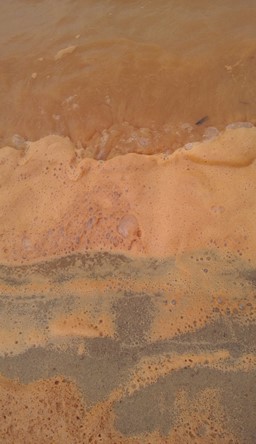
Image 5: Foam in the encounter of Doce River and Atlantic Ocean’s Waters in December 2015
When the mine tailings brought by the Doce river reached the Atlantic Ocean, an unusual orange foam formed, which, when it dries, can be dispersed by the wind. Some people even said that the turbid water could irritate and scratch the skin. In this context, the residents from the affected area were forced to stop using the water to irrigate cultivated lands and perform many domestic activities, especially ones which require ingestion. The same happened with the consumption of fish by villagers, which was subjected to recommendations concerning the long-term possible threats to human health, associated with the presence of heavy metals in fish flesh. One of these stipulates a maximum daily consumption of 200 grams of fish for adults and 50 grams for children.[4] For that reason, the fishing activities have been significantly impacted, although they persist because of their importance in local and non-local exchanges, whether monetary or not, and because of the lack of restoration from previous living conditions.
In addition to its appearance in December 2015, we also verified (and recorded) the presence of “Samarco’s orange” and its foam on other occasions, like in November 2016 and February 2020.
Image 6: Reappearances of Samarco’s orange and its foam
In the top left: the foam formed in the Doce river and Atlantic Ocean’s encounter is registered again; in the top right: Comboios’ beach, Regência Augusta, with “Samarco’s Orange”. Photos taken in November 2016 (with GEPPEDES-UFES)
In the bottom left: the encounter of Doce river and Atlantic Ocean’s waters; in the bottom right: Comboios’ beach, Regência Augusta, with “Samarco’s Orange” again, after some rainy days in the end of January 2020. Photos taken in the first day of February 2020, when we were told that the most critical days of turbidity had occurred five days earlier.
These problems involving the use of fresh and ocean waters, their beings and fluxes, and the changes in the relationships with them, brought up another problem: the quality of the underground water. And then we come back to the first lines and pictures of this text…
As soon as the mine tailings arrived, some villagers, apprehensive about the quality of the water, dug the soil or reopened old wells. By doing so, they sensed (or remembered) the groundwater smells of mineral oil, concluding that the water could not be used in many domestic activities, like drinking, cooking, bathing or laundry, or agricultural ones, like watering plants and animals. So, underground water was not a real possibility to replace Doce river water; rather, it was another possible source of contamination. Many villagers believe that the main cause of that is the oil extraction and distribution, although, on the other hand, we have heard some government technicians saying that underground water’s characteristics are “natural”, avoiding confrontation with the oil and gas extraction and distribution industries, which have significant political and economic power in the state.
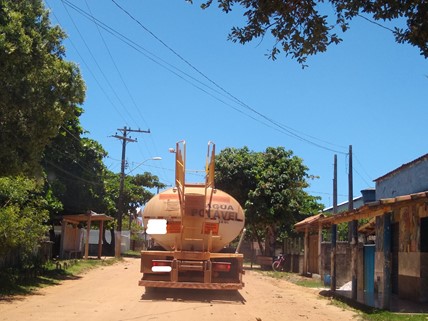
Image 7: A truck with drinking water supply arrives at the village of Regência Augusta (February 2020)
At Espírito Santo and Minas Gerais, the power of mining companies and their partners is present in daily life and political affairs. To illustrate this, we highlight an advertisement phrase from a steel company seen at Vitória’s airport on July 2019, which says: “We change the steel. The steel changes us”. This sentence has an ontological dimension, and reading it just some months after another great sociotechnological disaster happend again in 2019, in Brumadinho, Minas Gerais, seemed sarcastic or even insensitive.
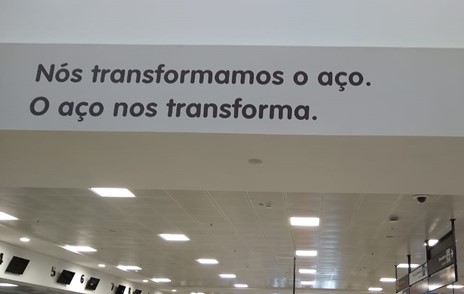
Image 8: Part of a steel company advertisement exposed at the airport in the capital of Espírito Santo which celebrates the steel’s ontology (July 2019)
Even so, we could use it to reflect on: to what extent mining exploration and consumption transforms us (and not only us)? What if we do not like what we have become and have done to both humans and non humans? Could we be less dependent on mining products and services, its agents and agencies?
Although it is not easy to answer these questions, we can stress that these are shared concerns with some people who live or work at Regência Augusta, who try to act in networks connecting the local to the non-local, and, sometimes, the material and the spiritual, in the search for alternatives. They are worried about building other links with the Earth in those painful contexts, trying to (re)create collective and individual ways to live in (and with) a healthier and better world. Even though they are not a large group and have certain class and ethnic biases, they do try to think and put into practice lifestyle changes, paying attention to some of their relationships with plants, E/earth, food, water, waves, and yet producing artistic expressions and artifacts. At the same time, they recognize the potent and undesirable presence of mine wastes in the Doce River and Atlantic Ocean waters and in the food chain, and the links between their own bodies and (not only) the mine tailings.
They are ‘noninnocent projects’, as termed by Donna Haraway (2016), as they try to bring new economic options to the village, whose waters and their aquatic beings constituted one of their main income sources, whether through fishing, surfing, or summer tourists. But they combine economic concerns with other values, such as cultural appreciation, environmental regeneration and care for the most vulnerable. So, we could say that there are different types of non-innocence. And that some are much more suspicious or cruel than others. How non-innocent are other projects being developed in the region before and after the dam disruption? The oil and gas pipelines and the “Samarco’s Orange” testify and remind us of that…
In these contexts, alternative efforts are important and demonstrate the human ability to reinvent, even in hard scenarios of destruction.
Below we present some pictures taken of these Terrans’ initiatives, as an attempt to honor them and, still, to try to restore the villagers’ (and others, including mine) hopes. Even if these hopes are tainted with several tones of “Samarco’s orange”, we can generate other meaningful tones and stories with the same E/earth and many of its beings.
Images 9, 10, 11 and 12: Regeneration attempts after dam collapse
Pottery works shown by one member of Coletivo Ceramística: on the left, a broken archaeological piece, on the right, a new piece that was successfully completed. These pieces are other examples of damage and recreation, of past and present presences. In this sense too, Areal continues to demand from the Brazilian State its recognition as an Indigenous Land [5]. Coletivo Ceramística and other collectives endorse this claim. Photos taken in February 2017 (with GEPPEDES).
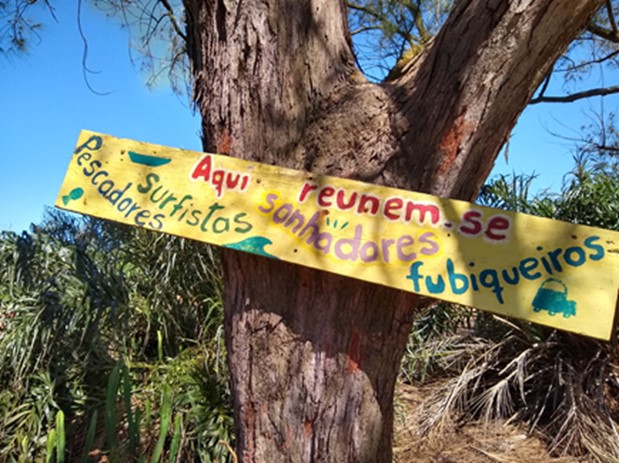
A board at Comboios beach, right in front of the village of Regência Augusta, we could read: “Here, dreamers – fishers, surfers and “fubiqueiros” (Carnival revellers) – meet”. Actually, it is it is possible to compose the words in different sequences (February 2020).
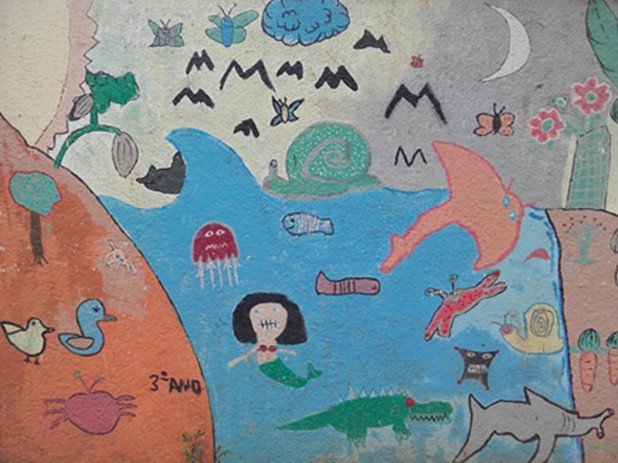
A wall painting made by 3rd grade children from the local public school, with strong references to aquatic lifes, and its fluxes, which was intensely impacted upon by the Samarco’s mine tailings (and not only). The painting was new when this photo was taken, in October 2017 (with GEPPEDES). In February 2020, although the dust had already covered some of its colors, the painting was still visible.
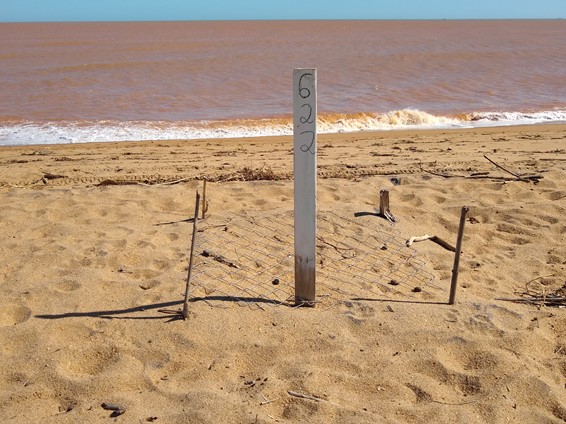
Sea turtle nest monitored by the sea turtle conservation project, TAMAR, and, in the background, “Samarco’s orange”. The critically endangered leatherback turtle (Dermochelys coriacea) from the southwestern South Atlantic population (see Torres et al., 2017) is one of the species that spawns in Regência Augusta (February 2020).
[1] All the pictures presented here were taken by the author, but on different occasions and according to the conditions of work and partners.
[2] In the project “Protected Areas and Major Development Projects in the Horizon of Experiences of Local Communities”, between 2015 and 2017, funded by the Ministry of Education (MEC), PROEXT-2016, coordinated by GEPPEDES-UFES (see CREADO et al., 2018; TRIGUEIRO et al., 2018). The project was not written to deal with this disaster and was also affected by it and had to be adapted to its occurrence. This author has developed research in Regência Augusta without the GEPPEDES’ team since 2011 and between 2018 and the present date.
[3] We especially recommend the studies developed by the research groups Organon (UFES, Federal University of Espírito Santo), GESTA (Federal University of Minas Gerais), PoEMAS (Federal University of Juiz de Fora), and GEPPEDES (Federal University of Espírito Santo).
[4] Recommendation of the Brazilian National Health Agency, named ANVISA, published as the Technical Note Number Eigth, in 2019. Available at: http://portal.anvisa.gov.br/noticias/-/asset_publisher/FXrpx9qY7FbU/content/peixe-do-rio-doce-deve-ser-consumido-com-moderacao/219201
[5] See this report that records Areal indigenous self-claim as well as a local demonstration, from January 2019, asking Petrobras for historical compensation https://seculodiario.com.br/public/jornal/materia/indigenas-de-areal-cobram-divida-de-40-anos-da-petrobras.
References
ASCOM/ANVISA. 2019. “Nota técnica número 8: Peixe do rio Doce, riscos do consumo”. Available at: http://portal.anvisa.gov.br/noticias/-/asset_publisher/FXrpx9qY7FbU/content/peixe-do-rio-doce-deve-ser-consumido-com-moderacao/219201
Couzemenco, Fernanda. 2019. “Indígenas de Areal cobram dívida de 40 anos da Petrobras”. Século Diário. Available at: https://seculodiario.com.br/public/jornal/materia/indigenas-de-areal-cobram-divida-de-40-anos-da-petrobras
Creado, Eliana S. J.; Helmreich, Stefan. 2018. “A wave of mud: the travel of toxic water from Bento Rodrigues to the Brazilian Atlantic”. Revista Do Instituto De Estudos Brasileiros 69: 33-51. doi: https://doi.org/10.11606/issn.2316-901X.v0i69p33-51
Creado, Eliana S. J.; Trigueiro, Aline; Crizio, Clara. 2018. Vidas de rio e de mar: pesca, desenvolvimentismo e ambientalização. Vitória: ProEx. Available at: https://www.researchgate.net/publication/329115584_Vidas_de_rio_e_de_mar_pesca_desenvolvimentismo_e_ambientalizacao
Haraway, Donna. 2016. Staying with the trouble. Durham, London: Duke University Press.
Silva, Bianca de Jesus. Coletivo Aliança rio Doce: Convivencialidade e Regeneração no Desastre na Bacia do rio Doce. In: IX ENCONTRO ASSOCIAÇÃO NACIONAL DE PÓS GRADUAÇÃO E PESQUISA EM AMBIENTE E SOCIEDADE, 2019, Brasília. Anais Completos do IX Encontro Nacional da ANPPAS, 2019. pp. 1070-1084.
Torres, Clara C. A.; Creado, Eliana S. J.; Campos, Ana C.; Freitas, Pedro L. T. 2017. “Repertórios em rede: o caso da mobilização de duas espécies de tartarugas marinhas em uma ação civil pública”. Vivência: Revista de Antropologia 1(49): 75-96, 2017. Available at: https://periodicos.ufrn.br/vivencia/article/view/12827
Trigueiro, Aline; Creado, Eliana S. J.; Zanetti, Daniela. 2018. Encontros de rios e mar: áreas protegidas e grandes projetos de desenvolvimento em Barra do Riacho e Regência Augusta (ES). Vitória, ES: PROEX-UFEX. Available at: https://www.researchgate.net/publication/329115587_Encontros_de_rios_e_mar_areas_protegidas_e_grandes_projetos_de_desenvolvimento_em_Barra_do_Riacho_e_Regencia_Augusta_ES
Tsing, Anna; Swanson, Heather; Gan, Elaine; Bubandt, Nils. 2017. Arts of Living on a Damaged Planet: Monsters and Ghosts. Minneapolis: University of Minnesota Press.
Zhouri, Andrea; Oliveira, Raquel; Zucarelli, Marcos; Vasconcelos, Max. 2017. “The Rio Doce Mining Disaster in Brazil: between policies of reparation and the politics of affectations”. Vibrant, Virtual Braz. Anthr. (online) 14(2) doi: https://doi.org/10.1590/1809-43412017v14n2p081
